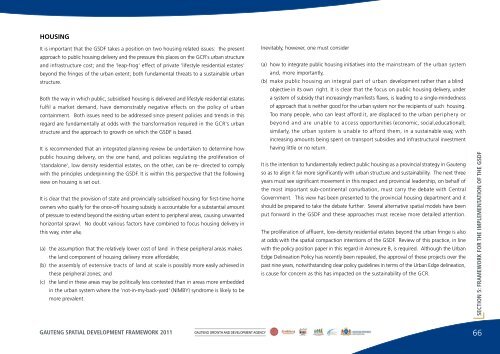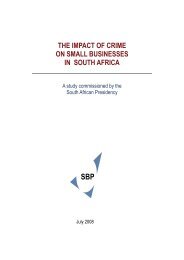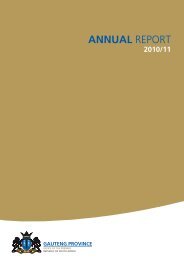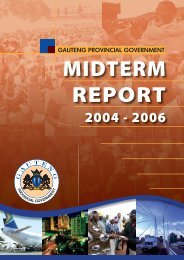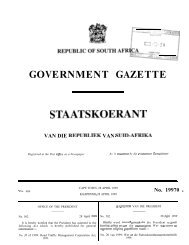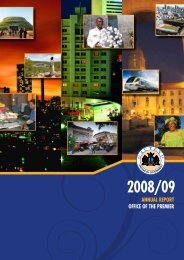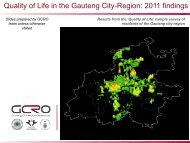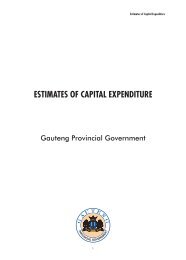the gauteng spatial development framework - Gauteng Online
the gauteng spatial development framework - Gauteng Online
the gauteng spatial development framework - Gauteng Online
Create successful ePaper yourself
Turn your PDF publications into a flip-book with our unique Google optimized e-Paper software.
HOUSINGIt is important that <strong>the</strong> GSDF takes a position on two housing related issues: <strong>the</strong> presentapproach to public housing delivery and <strong>the</strong> pressure this places on <strong>the</strong> GCR's urban structureand infrastructure cost; and <strong>the</strong> 'leap-frog' effect of private 'lifestyle residential estates'beyond <strong>the</strong> fringes of <strong>the</strong> urban extent; both fundamental threats to a sustainable urbanstructure.Both <strong>the</strong> way in which public, subsidised housing is delivered and lifestyle residential estatesfulfil a market demand, have demonstrably negative effects on <strong>the</strong> policy of urbancontainment. Both issues need to be addressed since present policies and trends in thisregard are fundamentally at odds with <strong>the</strong> transformation required in <strong>the</strong> GCR's urbanstructure and <strong>the</strong> approach to growth on which <strong>the</strong> GSDF is based.It is recommended that an integrated planning review be undertaken to determine howpublic housing delivery, on <strong>the</strong> one hand, and policies regulating <strong>the</strong> proliferation of'standalone', low density residential estates, on <strong>the</strong> o<strong>the</strong>r, can be re- directed to complywith <strong>the</strong> principles underpinning <strong>the</strong> GSDF. It is within this perspective that <strong>the</strong> followingview on housing is set out.It is clear that <strong>the</strong> provision of state and provincially subsidised housing for first-time homeowners who qualify for <strong>the</strong> once-off housing subsidy is accountable for a substantial amountof pressure to extend beyond <strong>the</strong> existing urban extent to peripheral areas, causing unwantedhorizontal sprawl. No doubt various factors have combined to focus housing delivery inthis way, inter alia,(a) <strong>the</strong> assumption that <strong>the</strong> relatively lower cost of land in <strong>the</strong>se peripheral areas makes<strong>the</strong> land component of housing delivery more affordable;(b) <strong>the</strong> assembly of extensive tracts of land at scale is possibly more easily achieved in<strong>the</strong>se peripheral zones; and(c) <strong>the</strong> land in <strong>the</strong>se areas may be politically less contested than in areas more embeddedin <strong>the</strong> urban system where <strong>the</strong> 'not-in-my-back-yard' (NIMBY) syndrome is likely to bemore prevalent.Inevitably, however, one must consider(a) how to integrate public housing initiatives into <strong>the</strong> mainstream of <strong>the</strong> urban systemand, more importantly,(b) make public housing an integral part of urban <strong>development</strong> ra<strong>the</strong>r than a blindobjective in its own right. It is clear that <strong>the</strong> focus on public housing delivery, undera system of subsidy that increasingly manifests flaws, is leading to a single-mindednessof approach that is nei<strong>the</strong>r good for <strong>the</strong> urban system nor <strong>the</strong> recipients of such housing.Too many people, who can least afford it, are displaced to <strong>the</strong> urban periphery orbeyond and are unable to access opportunities (economic, social,educational);similarly, <strong>the</strong> urban system is unable to afford <strong>the</strong>m, in a sustainable way, withincreasing amounts being spent on transport subsidies and infrastructural investmenthaving little or no return.It is <strong>the</strong> intention to fundamentally redirect public housing as a provincial strategy in <strong>Gauteng</strong>so as to align it far more significantly with urban structure and sustainability. The next threeyears must see significant movement in this respect and provincial leadership, on behalf of<strong>the</strong> most important sub-continental conurbation, must carry <strong>the</strong> debate with CentralGovernment. This view has been presented to <strong>the</strong> provincial housing department and itshould be prepared to take <strong>the</strong> debate fur<strong>the</strong>r. Several alternative <strong>spatial</strong> models have beenput forward in <strong>the</strong> GSDF and <strong>the</strong>se approaches must receive more detailed attention.The proliferation of affluent, low-density residential estates beyond <strong>the</strong> urban fringe is alsoat odds with <strong>the</strong> <strong>spatial</strong> compaction intentions of <strong>the</strong> GSDF. Review of this practice, in linewith <strong>the</strong> policy position paper in this regard in Annexure B, is required. Although <strong>the</strong> UrbanEdge Delineation Policy has recently been repealed, <strong>the</strong> approval of <strong>the</strong>se projects over <strong>the</strong>past nine years, notwithstanding clear policy guidelines in terms of <strong>the</strong> Urban Edge delineation,is cause for concern as this has impacted on <strong>the</strong> sustainability of <strong>the</strong> GCR.SECTION 5: FRAMEWORK FOR THE IMPLEMENTATION OF THE GSDFGAUTENG SPATIAL DEVELOPMENT FRAMEWORK 2011GAUTENG GROWTH AND DEVELOPMENT AGENCY66


